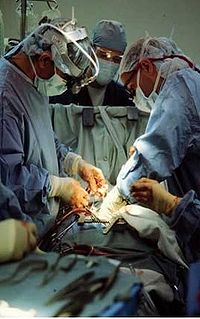
Photo from wikipedia
Component separation (CS) procedures have become an important part of surgeons’ armamentarium. However, the exact criteria for training, procedure/mesh choice, as well as patient selection for CS remains undefined. Herein… Click to show full abstract
Component separation (CS) procedures have become an important part of surgeons’ armamentarium. However, the exact criteria for training, procedure/mesh choice, as well as patient selection for CS remains undefined. Herein we aimed to identify trends in CS utilization between various cohorts of practicing surgeons. Members of the Americas Hernia Society were queried using an online survey. Responders were stratified according to their experience, practice profile (private vs academic, general vs hernia surgery), and volume (low (< 10/year) vs high) of CS procedures. We used Chi-squared tests to evaluate significant associations between surgeon characteristics and outcomes. 275 responses with overwhelming male preponderance (88%) were collected. The two most common self-identifiers were “general” (66%) and “hernia” (28%) surgeon. PCS was the most commonly (67%) used type of CS; endoscopic ACS was least common (3%). Low-volume surgeons were more likely to utilize the ACS (p < 0.05). Only 7% of respondents learned PCS during their residency, as compared to 36% that use ACS. 65% felt 0–10 cases was sufficient to become proficient in their preferred technique. 10 cm-wide defect was the most common indication for CS; 23% used it for 5–8 cm defects. Self-identified “hernia” and high-volume surgeons were more likely to use synthetic mesh in the setting of previous wound infections and/or contaminated field (p < 0.05). More general/low-volume surgeons use biologic mesh. Contraindications to elective CS varied widely in the cohort, and 9.5% would repair poorly optimized patients electively. Severe morbid obesity was the most feared comorbidity to preclude CS. The use of CS varies widely between surgeons. In this cohort, we discovered that PCS was the most commonly used technique, especially by hernia/high-volume surgeons. There are differences in mesh utilization between high-volume and low-volume surgeons, specifically in contaminated fields. Despite its prevalence, CS training, indications/contraindications, and patient selection must be better defined.
Journal Title: Surgical Endoscopy
Year Published: 2021
Link to full text (if available)
Share on Social Media: Sign Up to like & get
recommendations!